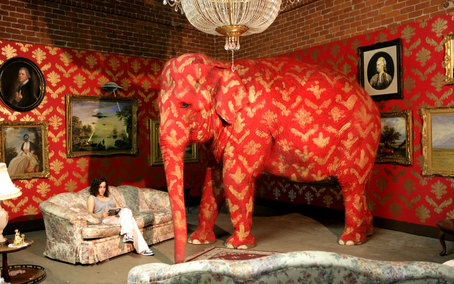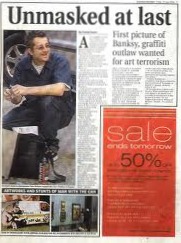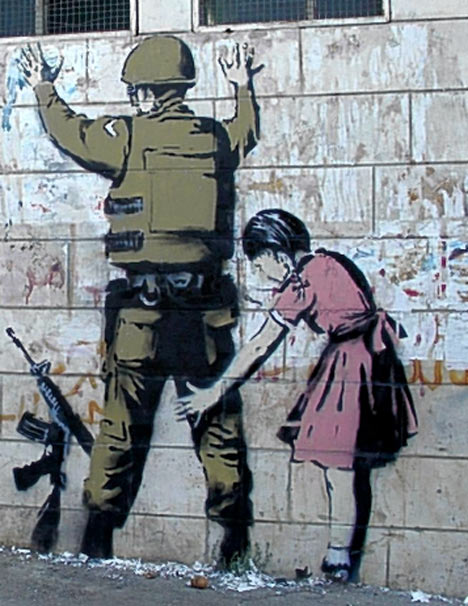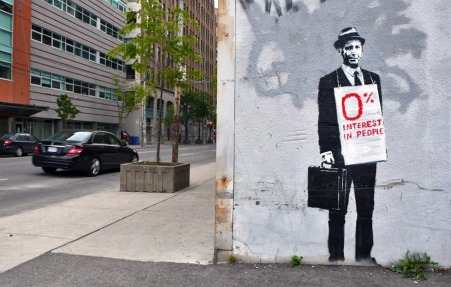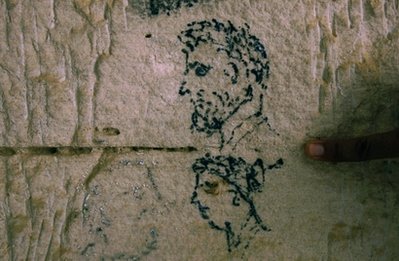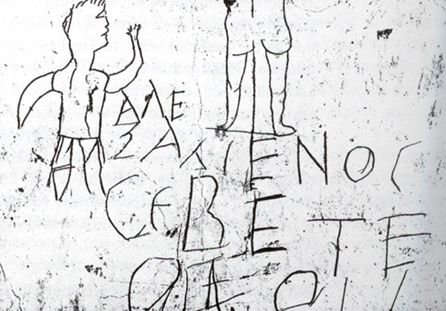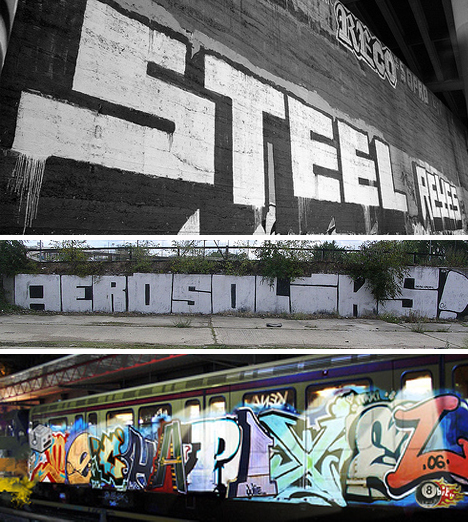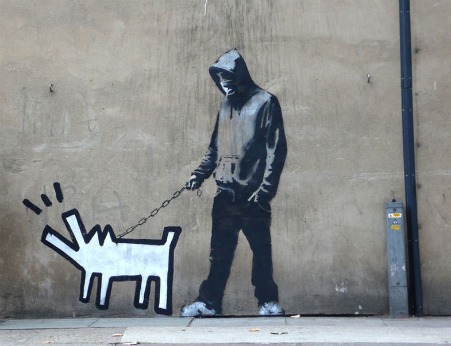Artopia: February 2011 Archives
BANKSY street art KILROY
Mr. Brainwash
JAMES FRANCO
graffiti KEITH HARING
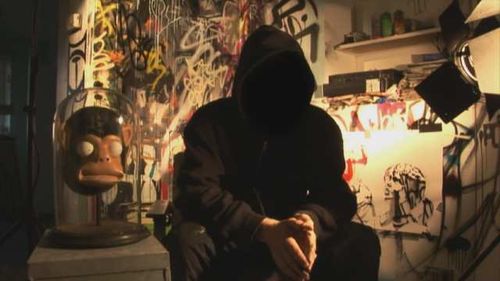
There are four basic human needs: food, sleep, sex and revenge.
-- Banksy
Banksy Pranksy
Even a great satirist would be hard pressed to think this one up: Famous British street artist is nominated for an Oscar for best documentary, a film that exposes the herd instinct of the public and the gullibility of the art world.
The movie is called Exit From the Gift Shop, a film by Banksy.
When Banksy is on screen, he wears a hoody that artfully obscures his face, and his voice is altered. Why the latter? Does he have an identifiable accent like maybe from Bristol, England, or thereabouts? Or a squeaky voice?
More questions:
Is Exit a joke? A hoax? A mockumentary? An exercise in the self-reflexive?
A po-mo promo?
Above, I first typed Exist Through the Gift Shop. Typos are auguries.
Whether the film was scripted in advance or improvised or even discovered during the editing process is irrelevant; it is still a pretty funny film. You will always be reminded of it when you are leaving the Guggenheim Museum in New York and you actually have to exit through the gift shop, one of the most annoying tricks ever played on the museum-going public.
Why not enter through the gift shop, save admission, and just look at the souvenirs -- which are sometimes better than the actual art? I routinely check out gift shops -- posters, cards, jigsaw puzzles, placemats, calendars and all such souvenirs of iconic artworks -- on my way out to make sure I have not missed any warhorses, because once or twice in museums other than the Guggenheim, I have, and had to circle back.
Actual art tends to be too big and far too grubby, right? Posters, cards, jigsaw puzzles, placemats, and calendars are neat, clean and useful as gifts.
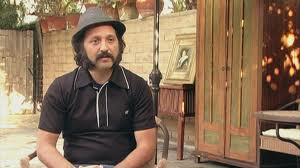
Thierry Guetta, L.A. rag-merchant, cinematographer, aka Mr. Brainwash. From: Exit from the Gift Shop
From Rags to Riches
Last week I noticed Exit Through the Gift Shop was available on Netflix instant-streaming. With the Academy Awards coming up, how could I resist? I approached it with trepidation.
Turns out I loved it, love the way it suddenly (spoilers! spoilers!) turns around and turns upside-down two-thirds through.
Exit begins as if amateur filmmaker and artist-stalker Thierry Guetta's footage -- and the footage of him shooting his footage -- is going to be all there is to the film. We start with Guetta's Parisian "cousin," the real-life Space Invader who specializes in hit-and-run mosaics.

And then on to other fabulously famous street artists like Shepard Fairey (celebrated for his Obama "Hope" poster).
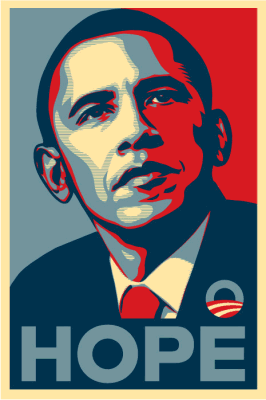
But the elusive Banksy, who in a possibly self-serving twist of self-imagining portrays himself as the ultimate goal of Quetta's quest, insists that he see some of the footage amassed by his fan, his sycophant. We are offered a brief sample of the first cut of Guetta's Live Remote Control. Quetta has been shooting himself in the foot. It looks like a parody of an art film. Bruce Connor takes on street art? Fast cuts; but unlike Connor, no guts.
When Banksy urges Guetta to become a street artist instead of a filmmaker, he surrenders his footage to Banksy and reinvents himself as Mr. Brainwash. The film we are watching, now overtly by Banksy, is suddenly all about a goofy, cartoon-French, used-clothing mogul living in L.A. who suddenly becomes a Street art celebrity through Banksy-type stencils of himself wielding a camera.
Very droll.
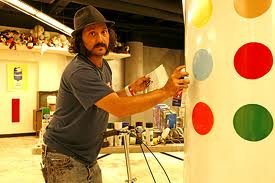
Thierry Guetta becoming Mr. Brainwash.
Cover of L.A. Weekly? Well, why not?
I checked it out in that rag's online archive. Yes, indeed. Here's a pic.
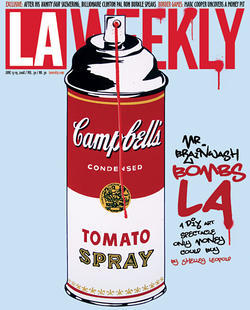
And, yes, like Banksy's self-produced "Barely Legal" '06 mega-exhibition in L.A., someone going by the name of Mr. Brainwash pulled off the same in '08, but called it "Life Is Beautiful."
Here's a blogger's description of the '06 Banksy show with lots of pictures.
Banksy's stenciled elephant from "Barely Legal," 2006.
Rumors now in circulation:
Banksy is Guetta.
Banksy, adding "comic actor" to his talents as artist and filmmaker, plays both Guetta and himself in the movie.
The real-live Guetta is the real-life Banksy, a Frenchman based in L.A.
Banksy, not Mr. Brainwash, is the faux artiste. Or....
Both were created by Jeffrey Deitch, ex-dealer from N.Y.C. and now director of MOCA-LA, in an effort to publicize his forthcoming "Art in the Streets" exhibition at the Geffen Contemporary.
Banksy is Brad Pitt, the art collector.
Banksy is James Franco, another multi-talented artist --- the smiling co-host of the 83rd Annual Academy Awards. He was nominated for best actor, and also lost.
Exit is a remake of Dream of a Rarebit Fiend (Porter/Edison, 1906, not 1903) or was actually made by Christopher Guest, the mockumentary genius.
Art on the Run
No doubt about it, Banksy, whoever he is, is famous. He may be the "former public schoolboy from middle-class suburbia" as claimed by the Daily Mail.
Or he may be a collective. But why should anyone care? Because many in high and in low places are taken with the Banksy brand.
What exactly is the Banksy product that has established willy-nilly or perhaps quite self-consciously the Banksy brand?
You can go to his website or, at least, what seems to be his website (everything is in doubt) and see some outdoor art, indoor art, and some souvenirs. The style is identifiable: relatively realistic stenciled figures up to something or another, usually no good. And it's all quite sarcastic. .
The stenciled images are ephemeral, except in those instances in which aggressive collectors have purchased entire walls or buildings in order to own (and surely later sell) authentic Banksy artworks.
Banksy is the new Damien Hirst. The new Andy Warhol. Let's hope he's not the new Salvador Dalí .
Banksy Portfolio:
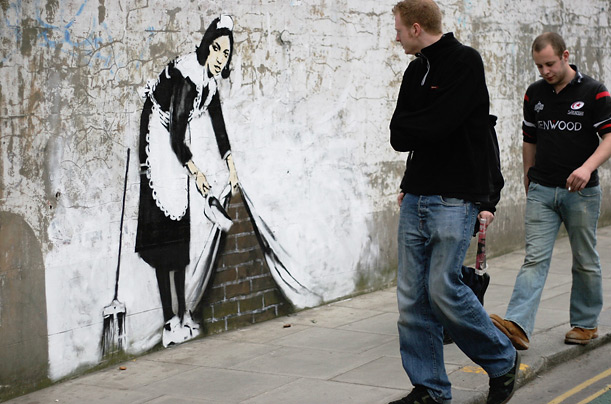
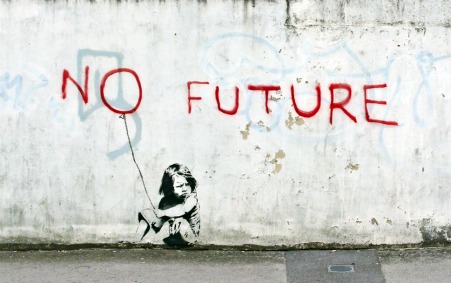
But where did it all begin?
A Brief History of Graffiti (Part One): Kilroy Was Here
Although vandalistic graffiti is ephemeral, it is in some ways eternal - or at least perennial. What is there about a flat surface in public that cries out for...speech. The impulse to leave your mark or to advertise yourself, taunt, or deface is apparently universal. Unsolicited additions to walls go back to ancient Egypt, to Rome and Pompeii, or to World War II.
Portolio:
Graffiti on walls of Kom Ombo Temple, Ptolemaic Dynasty, Egypt,350-30BC
Graffiti from city of Leukaspis, N.D.
Graffiti on wall in Pompeii
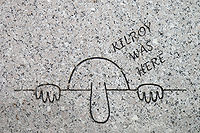
G.I. graffiti, W.W. II, Europe
A Brief History of Graffiti (Part Two): It's All About Love
Oh, yes. I remember modern graffiti. According to most accounts -- some of them quite academic -- it started in Philadelphia, c. 1966. Philadelphia has a lot to answer for, and not just the invention of solitary confinement at Eastern State Penitentiary. What became graffiti art was called "bombing" then, and Cornbread (Darryl McCray) and Cool Earl were the stars. Cornbread himself on his website dates his invention of graffiti to his love-starved youth. He was trying to impress a girl he was interested in. Cornbread was McCray's nickname in an unidentified "juvenile institution." But when he got out ...
I met this girl in school named Cynthia. I used to like Cynthia a lot. I would walk her home from school everyday 'cause I was trying to be her boyfriend. I started writing "Cornbread loves Cynthia" all over the neighbourhood (sic) She didn't know Cornbread and I were the same person, she just knew me as Darryl. It played on my mind 'cause Cornbread seemed to get more attention from her than I did. One day many months later, she saw "Cornbread loves Cynthia" written on my school book and she realized who I was. That's when she fell in love with me.
But b
A Brief History of Graffiti (Part Three): From Philly to the BMT
Suddenly "tags" by TAKI 183 began to appear in New York City. Did this happen spontaneously, or is there a special land bridge from Philly to New York as there once was from Siberia to North America?
First TAKI 183. Then whole subway cars got "tagged" by spray-can art. Styles proliferated at a breakneck speed. Writing went crazy: Wild style, Throw-Up, Blockbuster, Broadway, Bubble, WigglesB boy, Flava Wildstyle, Shadow, Chinese, Puzzle. Was it art? George Kubler once said if a group of things laid out chronologically exhibited rapid and nonfunctional modifications, we were probably looking at art of some sort. So much for the eternally transcendent.
In 1974, Norman Mailer, that champion of great art, published The Faith of Graffiti.
I have a soft spot for calligraphy -- Japanese, Chinese, and Arabic and, if you remember, pseudo-calligraphy in all traditions including the paintings of Brion Gysin --- but this guerrilla "writing" in New York was a nuisance. It was flamboyantly decorative; possibly territorial; and best seen as a new kind of urban folk art.
Spray-can graffiti spread like a weird fungus among us, from the BMT and the IRT to drainage ditches, elevated-roadway underbellies ("heaven"), rooftops, and walls. Hundreds of walls. Savvy art dealers began bringing it indoors. And I began to rue the day I had not ripped off the beautiful chalk drawings that Keith Haring did on the black surfaces of unrented advertising rectangles on subway platforms. Oh, that howling wolf. And the radiant baby.
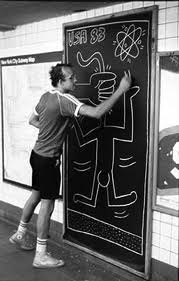
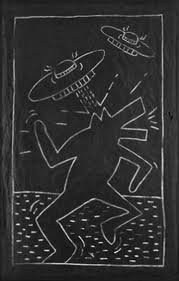
Bear in mind, however, that the kind of street art I was officially interested in -- we called it Street Works in 1969, in order to parody Earthworks -- was performance-based. A poet roller-skated down Fifth Avenue; a male artist walked 14th Street in drag. A soon-to-be-mad poet commandeered her own hotdog stand. Your truly made phone calls from phone booth to phone booth in Midtown, hanging up before the phones were answered. Street Works V, the final extravaganza, had 500 or so artist and poet participants. Although there was sometimes litter (Arakawa), the litter could be swept away. And although stencils were sometimes employed by the likes of maverick Thomas Lanigan-Schmidt, his rats and his words have eluded art history.
Art history is interested only in what is up for auction. "Object Art" stenciled on the street-level wall of the Whitney moat is the Lanigan-Schmidt contribution to guerrilla art I remember most. Then again, he did stenciled rats everywhere, knowing them firsthand in his Lower East hovel, which was wildly decorated with cellophane and permanent Xmas lights...and rats made out of aluminum foil.
It's the rats that are up for auction. 
And the writings-on-the-wall? Graffiti of the '80s is so yesterday; Haring was the best. But the rest, as they came in from the cold and had gallery shows? Nada. Even Haring was better outside. Will the same be true of Banksy? We cannot even bear to look at the paintings of poor, dead Jean-Michel Basquiat, in spite of the film about him. But maybe it's because of the Warhol collaborations, which are as if Duchamp were playing catch-up, ripping off some handsome, drug-addled teenager who had just come in out of the rain.
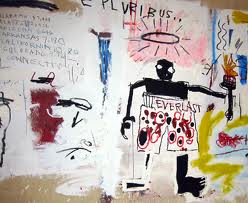
Basquiet graffiti
Bansky taking Haring dog for walk.....
Is Classification Pacification?
The "street art" entry on Wikipedia offers this definition: "Typically, the term street art or the more specific post-graffiti is used to distinguish contemporary public-space artwork from territorial graffiti, vandalism, and corporate art."
But it goes on to cite a 1981 exhibition at the Washington Project for the Arts in D.C. called "Street Art." The first use of street art as a term? When I checked it on the WPA site, it seems the exhibition was actually called "Streetworks"!
In any case, street art now is intended as art, whereas I would bet that the early graffiti artists -- before art-school dropouts took over -- did not think of their murals as having anything to do with Picasso or Diego Rivera.
But wait a minute. Weren't the graffiti loners and crews extremely competitive, just like real artists? Didn't they call their biggest works "pieces," which is short for "masterpieces"?
Here's a reference to street art that can be verified. The Tate Modern in 2008 had an exhibition called "Street Art." Blu, Faile, JR, Nunca, Os Gemeos, and Sexeart created murals on the Tate's river façade. Because the murals were legal and sanctioned, I don't think they were street art. But to give credit where credit is due, they were about street art. Got the words right; got the art wrong.
Have there been any earlier uses of the term? Scholars, please get to work. Confirmed sources only.
* * *
Whatever the date of origin, Street art fits the bill. Alternate terms such as post-graffiti and neo-graffiti don't really seem to work. Graffiti etymologically screams out words, yells out writing. And because of media exposure is identified with spray-can paint. Graffiti is not a large enough term to encompass the various kinds of unofficial, unsanctified art that continue to take place in the streets all over the world. Words, yes. But also images (stenciled, pasted, or whatever), objects (Banksy's bent booth), and various performance-based manifestations including flash mobbing. We needed a bigger term. A new term. And Street Art it is.
We can classify it but can we bring it indoors? Can it be saved?
Changing the context changes the meaning. Saving the art destroys it. Brackets betray. The way things are done now, hanging something on a white wall makes it art. But those very same white walls may do the reverse for street art, draining energy, canceling surprise, setting up unfair comparisons with art actually made for white walls (or at least posh living rooms).
The institutionalization of street art is the destruction of street art. If you like it, you will have to save it from being painted over or scrubbed away. You have to put a fence around it, own it, or bring it indoors. To save it, you have to kill it.
It almost goes without saying that if graffiti is institutionalized as transplanted walls or turned into translations of images onto stretched canvas or paper (i.e., drawings and prints), then all its deep aura is stripped away. The aurafication of contemplative display is no match for the rawness of illegal art. Street art must be a criminal act or it is just murals-as-usual. Also, beyond ghetto bravado -- which initially was enough - street art needs to have a message. Territorialization is not enough.
Banksy's images of a Royal Guard or a mutt peeing on a wall are funny and smart because they give away the territorial aspect of street art and certainly of graffiti before it was subsumed. He quotes Keith Haring. He appropriates Monty Python graphics. He pisses on everything. Banksy claims all walls. Banksy grabs street art for himself.
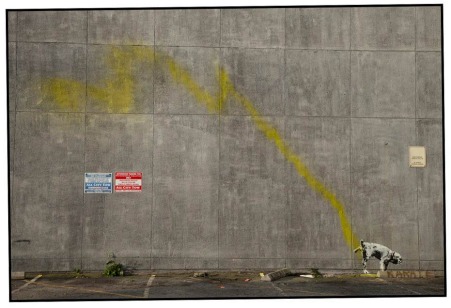
Flim-Flam or Meta-Film?
In the movie, Banksy's disdainful dismissal of the arty Guetta edit disguises the fact that Exit Through the Gift Shop is itself quite arty. The structure is more important than the subject. The structure is the content. Is this also a parody? Is this a criticism of the self-reflexive trope, so beloved by all in including the proprietor of Artopia? But also a criticism of the cupidity and complicity of artists, not only his alter ego (?) Mr. Brainwash, but even himself?
Well, maybe not that, or at least not blatantly, for how can you criticize an artist who gets into the limelight by staying out of the limelight, has a healthy secondary market, has good politics - I think --- and seems to be slamming both the art world, and casting doubts upon every other Street artist in the universe.
Mr. Brainwash's "Life Is Beautiful" had no painted live elephant like Banksy's breakthrough show, but looks as if it was jammed with Banksy rejects. Or as Banksy says: "Mr. Brainwash is a force of nature; he's a phenomenon. And I don't mean that in a good way."
Banksy is always quotable. He inherited the Warhol quotability quotient:
The greatest crimes in the world are not committed by people breaking the rules but by people following the rules. It's people who follow orders that drop bombs and massacre villages
Nevertheless, I smell an infinite regress. You have to make a lot of money to make a film satirizing making a lot of money. Hey, come on, even artists have to eat, and because Banksy is anonymous we do not know exactly how much he is worth.
To be fair, maybe all the money is being made by Banksy's collectors. However, on the evidence of his art, Bansky travels far and wide, and that costs money. It is also very expensive to remain anonymous. How much, by the way, would it cost to rent a former CBS studio to mount your own art show? To do it twice, the second time to make a faux-doc?
NEVER MISS AN ARTOPIA ESSAY AGAIN!
FOR AN AUTOMATIC ARTOPIA ALERT E-MAIL perreault@aol.com
John Perreault is on Facebook.
You can also follow John Perreault on Twitter: johnperreault
Preview: THE, A Novel by John Perreault.
SCULPTURE Steven Siegel ART Starn Twins ROBERT SMITHSON global warming GARBAGE Matthew Barney Black Mountain College BURGESS SHALE Marlborough Chelsea STEPHEN JAY GOULD Penland School BLACK MOUNTAIN COLLEGE Barbara Gladstone Twin Peaks Landfill PACIFIC GARBAGE VORTEX

What makes Steven Siegel's site-specific newspaper sculptures so special? What is so wonderful about his series of wall sculptures called "Wonderful Life"? And -- now -- what is the extra ingredient in Biography (at Marlborough Chelsea to Feb. 26) that allows me to claim we have a major sculptor on our hands?

 .
.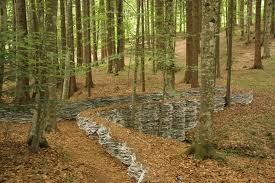

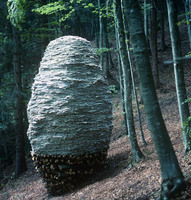

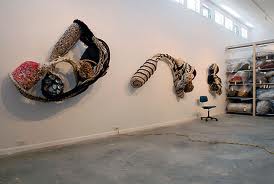
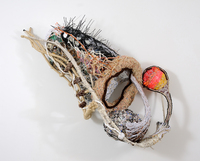
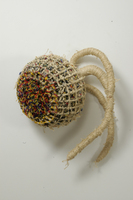
Siegel has been showing his sculptures for at least 30 years. But most of his work, until just this moment, has only been seen outside New York City
.
This may be because his work has usually been site-specific. But if truth be known, there is still a silence here --- in galleries and the magazines --- about art that is in the boondocks. Maybe an image here and there or an excellent interview in Sculpture Magazine -- which, let's face it, is not seen by all that many power-brokers or theorists, curators or collectors. Mike + Doug Starn can get a lot of attention for their photogenic but middling effort last summer on the roof of the Metropolitan Museum of Art -- a shaky, gimcrack lookout made of lashed-together bamboo -- whereas a sculptor as innovative as Patrick Dougherty, who for years has used the snagging of locally harvested saplings to make his "nests" and "lookouts" all over America, is unjustly neglected. Proximity is all. Proximity to power; proximity to media. Proximity is hegemony.
And so it seems that the reign of bad painting is not yet over. Painting is so portable, affordable, so automatically photogenic and so...easy to ship. And store. I love paintings.
Sculpture, by which I mean the actually physical mode of three-dimensional artmaking, is too cumbersome, bothersome, and troublesome. Takes up room; takes time. I love sculpture. And everything in between.
But sculpture, in fact, has lost out to painting since the rebirth of same in the gruesome '80s. Or was it the '90s? Painting was reborn, or so goes the legend, in Germany or somewhere in an art department in Upstate New York or perhaps California. Actually, in hindsight this was the death of painting, but no one was watching. They were too busy investing.
And why was sculpture lost? Unless it is super-cumbersome and super-troublesome like the work of Richard Serra -- who brilliantly seems to have cornered that particular market -- sculpture is not worth its weight in gold. It is not yet traded like stocks and bonds. Sculpture likes to stay put. We are not talking about the trinkets people once placed on their mantels or end-tables. We are talking about the big stuff.
Otherwise, sculpture is either Pop or not. We love Koons' Puppy, and Hirst is not the worst. But is this sculpture?
Well, we had better make some room for Steven Siegel and whatever else will be coming down the line.
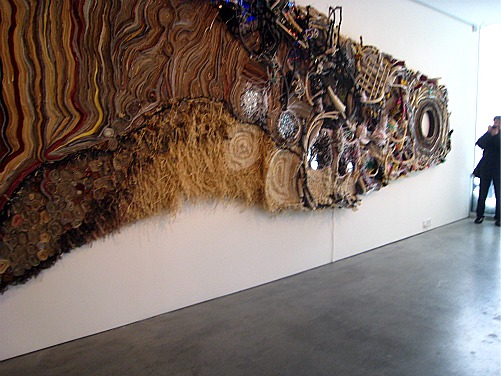
You May No Longer Go to the Head of the Class
Why has it taken so long for Siegel to gain visibility? The scouting system broke down and/or too much art is being produced for the system to function. No one knows how to sort or cull. Or -- and this is the killer thought -- beginning with dealer Barbara Gladstone's 1990 discovery of ex-Ralph Lauren model, ex-jock Matthew Barney when he was just two years out of Yale, it was thought to be easier to raid the art schools than actually scout for fresh blood in the hinterlands. Critics had long since given up scouting; they were content, like curators, to let the dealers do all the work. Hence the beginning of what is now called Art School Art: new, cheap, and no legs.
Then it got even worse. Collectors became the art scouts. Some were able to do a better job of it, believe it or not, than the professionals. And although this phrase is of questionable grammar, they put their money where their mouth is.
Now, at last, Art School Art is over. Collectors are only now coming out of hiding. And some dealers, I am told, will not even look at any artist who has an MFA from Yale or a grant from the Warhol Foundation or a Guggenheim. All too academic. The students now have students and aptly illustrate the law of infinite regress. Maturity might be the new norm. Playing catchup is the new game in museums and elsewhere. Endurance counts.

Jacques and Juliana Busbee, founders of Jugtown, c. 1922
Traditional ground hog kiln:
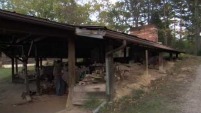
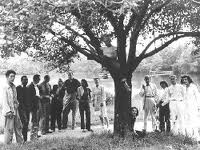
Black Mountain College faculty, c. 1951. Josef and Anni Albers, at extreme left.

Penland School, Penland, N.C. (founded 1923)
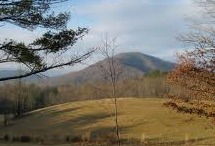
View from Penland School porch. Where are the llamas?
The Boon at Boone
In 2009, I wrote a catalog essay for an exhibition of Steven Siegel's art at the Turchin Center for the Visual Arts, Appalachian State University, Boone, North Carolina. North Carolina and I go way back. I once toured the Tar Heel State for its arts council and made a lot of discoveries for myself, not the least of which was the cluster of traditional farmer-potters in the Piedmont, where immigrated Brits with such family names as Cole, Craven, Owen(s), and Teague have been turning and burning their lovely wares for generations. Resuscitated by patrons and confirmed do-gooders Jacques and Juliana Busbee in 1922, already using drippy salt-glaze like the ancient Koreans, the Jugtown potters added some decidedly Asian forms to their lead-glazed and tobacco-spit jugs and dishes.
When I made my tour, Black Mountain College had long ago bit the dust. That was where -- students provided by the G.I. Bill -- Josef and Anni Albers, John Cage, Robert Creeley, Merce Cunningham, Willem de Kooning, Richard Lippold, M.C. Richards, Theodoros Stamos, and Jack Tworkov once taught. This is where Merce met Bob (Rauschenberg) and where the latter first made his all-white paintings.
Instead, I visited Penland School beyond Thomas Wolfe's Asheville -- now quite charming -- and deeper into the Blue Ridge Mountains. Penland School was founded in 1923 by Miss Lucy Morgan -- another do-gooder. Always called Miss Lucy, her goal was to save the mountain weaving tradition then threatened. Penland has since became a summer crafts school open to all and offering workshops in all craft media -- a school with llamas on the hill across the road, believe it or not. Llamas, the animals, not lamas. But there may have been some "hidden" lamas lurking about. Undercover as it were, I later took a pottery class there.
Boone was also one of my stops.
Years later, my Siegel essay came about because I juried an outdoor-sculpture show for Boone's wooded campus and it was clear that Siegel was the first-prize winner with his site-specific, outdoor newspaper pieces, Squeeze II.
When his solo exhibition in Boone, N.C., (not, I remind you, at Mary Boone in N.Y.) was slated, I was asked by the director of the Turchin Center to write a catalog essay. I previewed the new work at Siegel's studio in Red Hook, Dutchess County, New York.
When I saw the new work I was nonplussed.
It took me awhile to adjust. The exhibition was going to consist of 52 wall pieces inspired by Stephen Jay Gould's exposition, in his book Wonderful Life, of the discoveries of the Burgess Shale and what they might portend.

Hallucigenia from the Burgess Shale. (Mary Parriish}
The shale high up in the Canadian Rockies near Banff (and then other sites in China, Greenland, Siberia, Australia and the U.S. from the same time) presents a biological puzzle. Why was there, way before the age of the dinosaurs and even before the horseshoe crab, this remarkable proliferation of life forms? More life forms than now exist, many of them gone, but astounding in their variety? We are talking about unexpected, previously unknown phyla, not species. More phyla then those now extant. Does Creationism rear its head? Darwinian evolution punctured by a biological explosion caused by sudden climate change? A comet, continental shift, a tilt of the earth's axis?
I looked. I pondered. I got it.
Siegel, in his use of countless materials to generate, via the Burgess idea, a proliferation of forms, was using variety as opposed to uniformity, inventiveness as opposed to reason. He was not illustrating the Burgess Shale idea but identifying with it.
The closest artist I can think of is Robert Smithson. We are talking about Time, about ideas in art that go beyond quoting texts and putting them up on a wall, about subject matter and form fully integrated. Smithson was nourished by geological time and by Gondwana, the ancient super-continent in the Southern Hemisphere that finally broke apart to become South America, Australia, Africa.
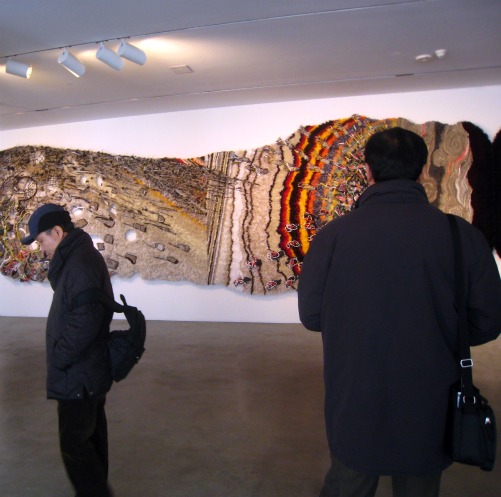
Now Biography, Siegel's new 75-foot wallpiece, tackles not only trash and time (like his outdoor sculptures), but time in a different way. The outdoor site-specific, layered-newspaper pieces reference time through dated newsprint layered like geological strata, and because of their ultimate disintegration. The layers become soggy, moldy. They sink, they rot. Nature is back on top.
In Biography, the time is a time of its own making; studio time, moving from the snake's "head" backwards to the left. The work has not been seen in its entirety before. It is too big even for Siegel's studio. The photo he sent to various galleries -- which, in fact, was what got him the current show at Marlborough -- was a composite. Unsolicited photo wins sculptor blue chip gallery! If you read it first in Walter Robinson's Artnet, you may have thought this was a joke. But I confirmed it with the artist. It's true.
In the second-floor gallery of Marlborough, Biography takes up two walls across one corner. Ropes, wires, Christmas-tree lights and what have you. The quotidian. The kind of stuff you just throw out without thinking about it. Trash transformed.
Kurt Schwitters pioneered the use of effluvia in art and was then followed decades later by Robert Rauschenberg. Perhaps we now have a Schwitters and a Rauschenberg specifically for our time. We certainly need one.
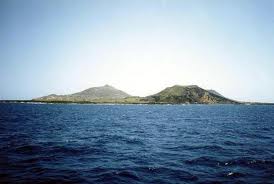
Garbage In" Is Not Always "Garbage Out"
From my point of view, the use of trash as an art material is another attack on what I call the art-supply- industry hoax that keeps the unwary and the ever-hopeful pre-artist frantically stocking up on expensive paints and linen canvases. And I am all for further destabilizing the idea that art must be made of certain sacrosanct materials.
But a concerted effort to use garbage instead of bronze or marble to make sculpture will not solve, alas, our garbage problem, as symbolized by the Texas-sized Pacific Vortex of floating plastic circling somewhere between Seattle and Hawaii. There is an Atlantic Vortex too, somewhere between Argentina and South Africa. I hope I do not have to remind you of this again.
Nor will the garbage-into-art initiative -- which is mine, not Siegel's -- demolish the double-breasted garbage dump that looms over Sunrise Highway on Long Island, the one dubbed "Twin Peaks" by droll Suffolk County locals. This so-called landfill is rumored to be the highest point (or highest two points) on Long Island. Photos show that from the Twin Peaks you can indeed see Long Island Sound to the north and the Great South Bay to the south. I hasten to add that two big breasts of garbage is not quite the proper way to honor Mother Nature.
Given the latest Global Warming surprise -- New York City switching places weatherwise with Buffalo -- Twin Peaks might double as ski slopes or downhill- racing venues. Snow as high as a Buffalo's eye, in Suffolk County? Had you ever before heard of the Arctic Fence, now breached, or the Arctic Vortex? What will they think of next.
I have better hopes for the Artopian idea to use garbage to form new barrier reefs against the rising tide that will otherwise flood so much expensive shoreline property.
Full fathoms five thy father lies;
Of his bones are coral made;
Those are pearls that were his eyes;
Nothing of him that doth fade,
But doth suffer a sea-change
Into something rich and strange.Sea-nymphs hourly ring his knell:
Ding-dong.
Hark! now I hear them -- Ding-dong, bell.
Ariel's Song," The Tempest, by William Shakespeare
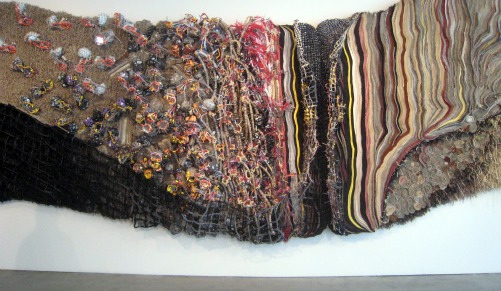
We Now Want Smart Art and Smart Artists
That said, it should be noted -- and noted rather strenuously -- that there is a lot more going on in Siegel's art than just layers and knots of stuff. Surely there is irony and ecology, but there is also brains. And a gift for the aesthetic. In art, one is not any good without the other.
I understand that playing dumb can be fun and sometimes smart -- smart as in "fashionable," and even smart as "intelligent." The hedgehog outlasts the fox. Intelligence is threatening. But had Conceptual Art gone too far? I say it never went far enough. In any case, boredom with language and such was no excuse to turn off the lights on thought, leaving bad painting to rule.
Dumb deep down is just dumb. There are many kinds of intelligence. Not everyone has to be a verbal whiz-kid; not everyone has to know Greek rhetoric or calculus. Great dancers and athletes have kinetic intelligence. There is even emotional intelligence. The heart can be wise. But the dumbing down of art has gone far enough.
My heart bleeds for you, when you complain that a certain artwork makes you think. So what else should it do? I vote for making you get up and dance; I vote for making you weep; but I do not vote for confirming mental conformity.
Siegel's art is about transformation, and an alchemical one at that. Biography is breathtaking. This is an artwork that has presence; the elevator door opens and you are in a new world. We have suffered long enough from Dumb Art or Tweedledum-and-Tweedledee Art. Siegel turns everyday waste into sculpture, foregrounding transformation as revelation. Beauty, therefore, can be released from even newspapers and Christmas tree lights. It's a great day for art.

NEVER MISS AN ARTOPIA ESSAY AGAIN!
FOR AN AUTOMATIC ARTOPIA ALERT E-MAIL perreault@aol.com
John Perreault is on Facebook.
You can also follow John Perreault on Twitter: johnperreault
Preview: THE, A Novel by John Perreault.
